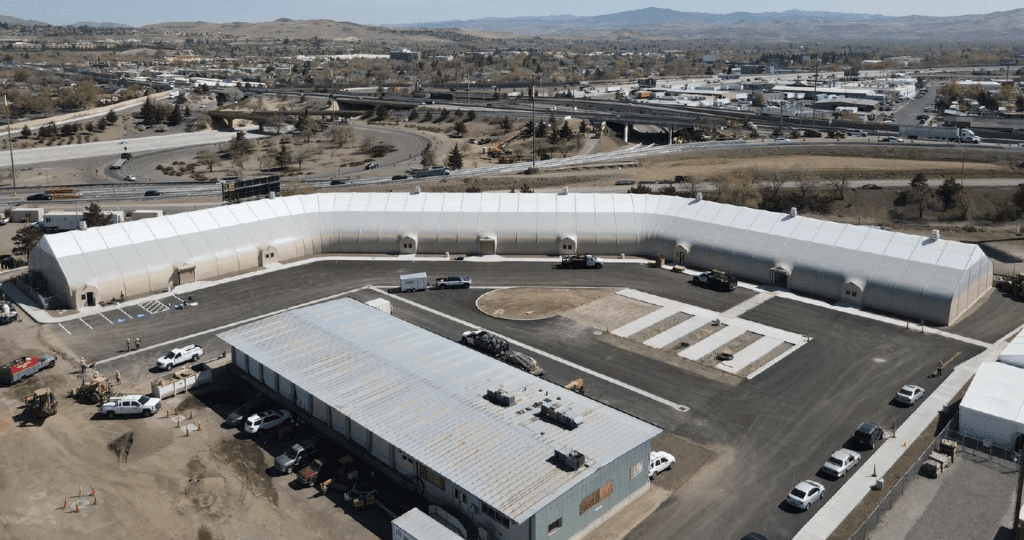
Nevada Cares Campus
ne of the major reasons we haven’t put a dent in SJ’s homelessness crisis is that our approach has been scattershot, not strategic—a long list of small-scale bureaucratic maneuvers. So says Irene Smith, D3 CM candidate who provides an update to her 2022 Incremental Ladder of Housing Success proposal, which focuses on a step-by-step approach to interim housing solutions, starting with large-scale community shelters. An Opp Now exclusive Q&A.
Opportunity Now: You call your homeless strategy the Incremental Ladder of Housing Success. You launched the concept when you ran against Omar Torres in 2022. What were the elements of your plan then, and how has it changed?
Irene Smith: It was conceived as a series of steps—or rungs on a ladder—to help people get off the streets and into better and better housing arrangements over time. It was based on the realization that solving homelessness is a process that requires different tactics at different points in time. But the most important component of that process is the belief that we need to “start where people are.” Which means in tents, on creeks beds and parking strips, often confronting serious mental health, addictions, and personal financial crises. And with that abiding conviction that everyone—everyone—in these moments of personal crisis should be receiving shelter and services.
ON: So what are the first rungs of your ladder for people who are living on the streets or creeksides?
IS: The majority of the San Jose unhoused (6,300) are unsheltered people (5,500) who are living in public spaces, in tents—it’s a tremendously unsafe and unhealthy environment. Mortality rates among our neighbors living like this are simply shocking, and the standardized mortality ratio for unhoused people is 3.8, compared to the general population in SCC. To me, it’s just 100% unacceptable. So we have to start there and ask: what’s the fastest, most effective way to get our neighbors out of these tremendously risky environments—ASAP? And the answer is: helping them transition to the first run on the Housing Ladder—shelters that keep them safe from the elements and crime.
ON: Do they have to be large-scale shelters?
IS: In a perfect world, no, but it’s the only way to do it quickly given our current situation. A strategy of creating an uncoordinated series of safe sleeping sites like Waston Parks across the city will take years and years of work and lots more debate, and probably never, ever, reach the capacity we need. Watson Park, for example, will only provide shelter for 56 homeless individuals when it opens in March 2025 with a future capacity of 220 tents. We have 6,300 unhoused in SJ. And it will take at least six months from idea to implementation to get Watson up and running, and this assumes no friction from neighbors who were ill-informed of the process. This is a go-slow approach when we need to move much faster. Watson Park can be a good pilot for ILHS; we can get a lot of kinks out of the process, but we shouldn’t stop there.
We get economies of scale from the large-scale structures. Arguably, we can get higher quality services. But mostly, we get speed and scale. Every single day our homeless neighbors remain on the creeks, they are at risk. And if we are serious about helping them avoid danger, speed is of the essence. Sprung structures can be put up within two weeks’ time and functioning between 2–5 months.
This idea that we have to wait until we build $1m new subsidized housing—which can take a decade to complete—before we do anything about changing these people’s conditions is just heartless and cruel.
ON: So what happens in that first rung of the ladder, in the large-scale sanctioned encampments?
IS: These are large-scale community shelters, often using sprung structures that provide relief from the weather and safety. On that site, we can provide services, treatment, and job training, a whole range of services like P.O. boxes and rehabilitation addiction and mental health group therapy and job training. But the key point is that they’re in the system, we have one point of contact with them, and can start to bring our government services to bear on their issues.
ON: So people have moved off the creeks and streets into the shelter and started getting services. What comes next? How long would they stay there? Would you put a time limit? If there’s no “next rung” available for them, do they just end up back on the creeks in a never-ending doom loop?
IS: The next run on the ladder needs to be smaller, higher quality interim shelters and housing. We should view the large-scale community shelters as a high-quality, but temporary solution that allows us to get them onto the ladder of housing success. It’s a starting point, like the lobby of a system that will move them into better and better arrangements in time. The future units will require more and more sobriety and treatment along the way. And then, start providing customized, individualized solutions that move our neighbors to a better place. Those solutions can be customized to the individual: it could be Homeward Bound—in which we reconnect people with their families and hometowns. It could be other, smaller community shelters like the great work being done by the Salvation Army and CityTeam with their community shelters in SJ. It could be providing rental vouchers to move into existing, vacant housing. Or it could be finding placement for them in some of the permanent supportive housing we have built. It could be group homes or rooming houses. And from there, they can go to their own apartment using Section 8—or hopefully, once they’ve landed a job, getting loans to become a first-time home buyer.
They move when they are ready and when we have an option to offer them. We won’t have a $1.1m apartment available for everyone as in the PSH model, but we will have good quality homes along the ladder of housing success so that when folks are ready and we are ready, they can graduate to the next level.
We know that homelessness is not a one-size-fits-all problem, so it can’t have a one-size-fits-all solution.
As an aside, I’m so encouraged that the Salvation Army is about to fully fund a women’s shelter in SJ. Women are the largest growing segment of the unhoused population.
But the point is to move them asap from creekside living—and into a system that gives them a chance to find the right answer for their needs and where our resources can be put to good use immediately.
The idea of building subsidized new housing for everyone on the creeks is a pipe dream. As Mayor Mahan says: we can never subsidize our way out of this problem, and it was deeply misguided to ever think that we could. But we should and we can provide decent, safe shelter.
ON: Housing First always has struck us at Opp Now as a camouflaged public housing scheme.
IS: And even if we could afford it, it’s not the right approach, as all it does is create a culture of eternal dependence for people who would benefit from group therapy and accountability, when in fact we should be working to get them to stand on their own and rejoin the community as equal members. The fact that when I walk into a PSH, the Abode cubicles for therapy and rehab are often empty because it isn’t required—Housing First created a systemic response to homelessness that never allowed the client to be accountable to themselves or to their community.
ON: Do we have to somehow require people to move to the community shelter? If we cite people for public camping, isn’t that criminalizing homelessness?
IS: If these people really don’t have any other place to go, I don’t see how we can cite them. And running up fines for people who are broke is ridiculous. And throwing them in jail does nothing to solve anyone’s problem.
But here’s the key point: as soon as the large-scale shelters are available, they have someplace to go. So that means the city and county and private property owners are completely in their rights to say: “You can’t camp here.” And demand they leave. At that point, the shelters become the only available place for them—and a much better place for them. So it’s a bit of both carrots and sticks, but gets us to the right place.
Read more here (behind paywall).

